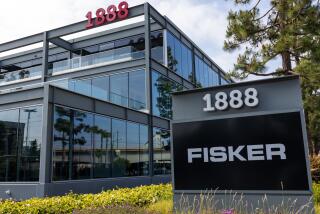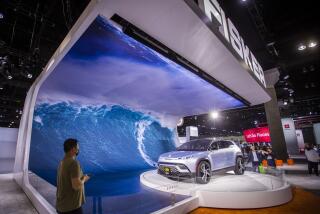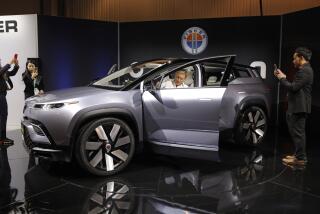Chrysler CEO outlines plan for carmaker’s survival
- Share via
Reporting from Detroit — Can Chrysler be saved? If you ask the steadily confident Sergio Marchionne, the answer is yes. After all, he did something like it before, bringing Italian carmaker Fiat back from financial disaster.
Now the Fiat chief executive, who also heads Chrysler, needs to convince North American consumers that the brand is here to stay and that it makes cars and trucks they want to buy.
“We aren’t going to bank the future of this house on one truck or one vehicle. You can’t. We tried that before, and one car won’t save the house,” he said.
Dressed informally in a navy-blue sweater and blue shirt, a marked contrast to the gray- and black-suited auto executives circulating through the North American International Auto Show in Detroit on Monday, Marchionne outlined a vision of a Chrysler reinvigorated through swapping technology, engineering and vehicles with Fiat.
He described his work as a “tedious rebuilding of a mosaic” of customer service, the market’s perception of the quality of Chrysler vehicles and the way the brands are marketed.
One cheerleader is U.S. Transportation Secretary Ray LaHood.
“I consider Sergio Marchionne as the Lee Iacocca of his generation,” LaHood said in an interview with The Times on Monday, referring to the former Chrysler CEO who helped resurrect the company in the early 1980s.
LaHood said he recently spent an afternoon with Marchionne and believes he has the “vision” to create a global partnership between Chrysler and Fiat that will “bring the American automaker into the 21st century.”
The auto industry is more skeptical.
“Chrysler has an uphill battle. It’s hard to see how they will make it through the next 12 to 18 months with the product selection they have,” said Jessica Caldwell, an industry analyst with car information company Edmunds Inc.
But if someone is going to save Chrysler, it’s likely to be Marchionne, said Rebecca Lindland, director of the autos group for IHS Global Insight, an economic forecasting firm in Lexington, Mass. “He has done a remarkable job with Fiat. He turned the company around even though people had a lot of doubts,” she said.
The son of Italians who moved to Canada when he was 14, Marchionne worked as a lawyer and accountant there before moving to Europe to run a couple of Swiss companies. A growing reputation as a restructuring expert landed him a seat on the board of sputtering Fiat. A year later, in 2004, he was chief executive.
Marchionne quickly shook up the management ranks, sacking dozens of entrenched executives. He overhauled production, revamped the lineup and boosted morale of a beaten-down workforce.
Marchionne became CEO of Chrysler after Fiat took over management of the Auburn Hills, Mich., carmaker when it emerged from bankruptcy in June. Fiat took a 20% stake in Chrysler as payment for operating the company. Its stake can grow to 35% if it achieves certain goals, such as building new engines and vehicles in the U.S. Fiat once sold cars in the U.S. but withdrew from the market in 1983.
At Chrysler, Marchionne’s challenge is that the automaker has few new vehicles in the product pipeline and it will be years before he’s able to leverage Fiat’s design and engineering reputation to sell cars in the U.S.
He’s going to start with the Fiat 500, or Cinquecento in Italian -- a tiny car smaller than even BMW’s Mini Cooper. It’s incredibly popular in fuel-sipping, narrow-street Europe, but industry analysts doubt it’s the type of vehicle that will gain acceptance with traditional Chrysler customers -- drivers of Hemi-engine-powered pickups in America’s heartland. It will be built in Mexico and is expected to go on sale late this year or in 2011.
And Marchionne said he was under no illusion that the small car would have an outsize effect on Chrysler sales. At best, he said, it would sell 100,000 units in the U.S., less than half its European volume.
The first larger Fiat-based Chryslers will hit showrooms sometime in 2012. Marchionne expects that just a couple of years later, more than half of Chrysler’s models will be based on Fiat platforms.
“He needs to get the company through 2010 and 2011, and then new products start to roll out,” Lindland said.
There’s not much in the near term. In addition to the Fiat 500, the company will launch new generations of the Jeep Grand Cherokee SUV, the Chrysler 300, the Dodge Charger and a Dodge utility vehicle later this year.
The dearth of products was evident on the floor of the Chrysler pavilion at the show in Detroit’s Cobo Center. People flocked around the Lancia Delta -- built by the Fiat division but badged as a Chrysler -- and gas-powered and electric versions of the Fiat 500. They paid little attention to the Chrysler products that were actually for sale domestically.
Marchionne said enough would be done to keep the company going as it works to overhaul its lineup and image.
“Let’s not confuse the process of repackaging existing material with the work going on here to drastically change the product portfolio,” he said.
Chrysler will have more than 20 new or redesigned vehicles in dealerships by 2014, and many will be far more fuel-efficient than the products they are replacing, he said.
The Italian executive is dealing with an automaker that’s well behind the rest of its North American competition in pulling out of the industry nose dive of the last year.
Chrysler has sunk to just 8.9% of the U.S. auto market, well behind far-better-financed rivals Ford Motor Co., Honda Motor Co., Toyota Motor Corp. and even General Motors Co., a fellow survivor of bankruptcy. Chrysler’s sales fell to 931,402 vehicles in 2009, its lowest level since 1962.
But Marchionne noted that autos have a longer life span in the marketplace than most people realize and that with smart marketing and targeted improvements, especially on what he and other company executives described as the lagging interiors of the vehicles, the company can survive until the new offerings roll into showrooms.
“We know this year will be difficult,” he said, but the company has planned for the drought and is not burning up its cash.
Chrysler has $5 billion to $6 billion in cash, “enough to see us through” to the new product offerings and collaboration with Fiat, Marchionne said.
Marchionne believes that careful management and what’s in the pipeline will do the trick.
He said that with “discipline,” Chrysler could break even on sales of 1.1 million autos in the U.S. and an additional 500,000 in Canada, Mexico and international markets. That would require more than 20% growth combined from the 1.3 million vehicles the company sold globally in 2009.
Chrysler’s turnaround plan calls for the automaker to nearly triple its sales to 2.8 million in 2014, with growth coming from both the U.S. and overseas, where it sells only a small percentage of its production now. Such growth would increase its U.S. market share by more than 5 percentage points to 13%, making it almost as big as Ford is now.
But Marchionne said he was not going to increase production unless it was supported by genuine demand for Chrysler products.
“We know what unprofitable volume looks like. We are experts,” he said. “We know that doesn’t work and that we have to find another solution.”
twitter.com/latimesjerry







